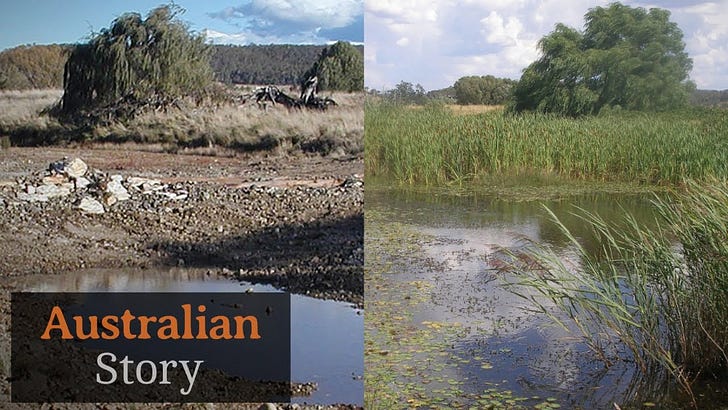In this podcast I had the honor of talking with David Maher about his work with Natural Sequence Farming, which is a landscape system to restore natural water cycles. We talk about how the water cycles impact drought, heat waves, rain, storms, and extreme weather. He advocates for urgent reversal in the global paradigm of drainage in the face of ecological and climate collapse, and is a firm believer that humanity either rehydrate the drained earth or face eventual desertification. I believe his voice needs to be heard a lot more in the regenerative water movement.
David Maher is a master of rehydrating landscapes and replenishing groundwater, with two decades of experience in the field. He studied and worked with Peter Andrews (of Natural Sequence Farming). He learnt with aborigines who understood how the water moved in Australian landscapes. He has studied sustainable agriculture, terraced aquaculture, Fukuoka’s work, and learnt from Hakai Tane, and Tex Skewthorpe. Hakai Tane’s influence opened him up to systems science and complexity theory in understanding the water cycle. Michael Kravcik, Jan Pokorny, and Wilhelm Ripl visited them Peter Andrews and their work in Australia, which further helped him integrate the various aspects of the water cycle into his understanding.
I find his way of framing Natural Sequence Farming quite intriguing, and also the way he looks thermodynamically at what is happening in the atmosphere and land in regards to water. He talks about how the land will heat up because we are not transferring away as much of that heat through evapotranspiration (we are not turning the heat of the land into latent heat), this means that we upset various heat balances on the planet, changing the temperature gradients, which leads to more extreme weather.
Time stamps:
1:30 Natural Sequence Farming
16:35 Wetlands
42 thermodynamics and water
50 evapotranspiration and droughts, heat waves
1:02:40 dissipative structures, hurricanes, extreme rain, atmospheric rivers, water cycles, nonequilibrium thermodynamics. He discusses the interesting the idea that as we dissipate less energy in the landscape as wetlands disappear, then we will dissipate more energy in the atmosphere, and have more extreme weather events.
There are some more slightly advanced topics in this podcast so looking at some of the previous articles in this newsletter htts://climatewaterproject.substack.com can be useful .
You can download this podcast on the Subtack app. It is on Apple podcast and Spotify as the Climate Water Project podcast.
Also here is a glossary of terms used in this podcast
r strategist - organisms that reproduce quickly in unstable environments
k strategist - organisms that are living in stable environments. As an example you can have weeds and grasses as an r strategist that comes in first into environment. They then pave the way for k strategists which are the trees.
leaky weir - a structure in the river to slow down the water like eg. check dam, bed control structure, and beaver dam analogues
biotic pump - This hypothesis states that when water vapor, evapotranspired from forests, condenses to form clouds it creates a low pressure system that attracts ocean winds to it, that carry more water vapor to the forests. So forests create their own rain.
second law of thermodynamics - entropy always increases
sensible heat - the heat you can feel in the atmosphere
latent heat - when liquid water turns into water vapor, some of the heat is stored as latent heat. When water vapor condenses back into clouds it releases that latent heat.
short water cycle/ small water cycle - water that evapotranspires from the land, then falls back to land as rain, and so on.
nonequilibrium thermodynamics - the study of systems and how they transport heat and matter when a system is out of equlibrium. The earth is in state of nonequilibrium as the sun is constantly hitting it with energy.
dissipative structure - a stable state of a system in a nonequilibrium thermodynamic system. So for instance a hurricane is a stable structure that happens when there is a large flow of water vapor flowing upwards through the eye of the hurricane. It might be argued that the small water cycle is a dissipative structure.
Further reading
Natural Sequence Farming https://www.nsfarming.com/
Peter Andrews “Back from the brink” https://www.goodreads.com/book/show/3747340-back-from-the-brink
ABC news show about Natural Sequence Farming
Wilhelm Ripl “Water the bloodstream of the atmosphere” https://pubmed.ncbi.nlm.nih.gov/14728789/ for a thermodynamic perspective on water. Go to sci-hub.st/ and type in the doi number of the paper to get the whole paper to read for free (sci-hub allows you to read any scientific paper for free)
Kravick, Pokorny, Kohutiar, Kovac, Toth “Water for the recovery of the climate: a new water paradigm” https://bio4climate.org/2017/05/13/water-for-the-recovery-of-the-climate-a-new-water-paradigm/
…
This is a reader supported publication. Please consider subscribing at the $5 a month to help this regenerative water movement.













Share this post